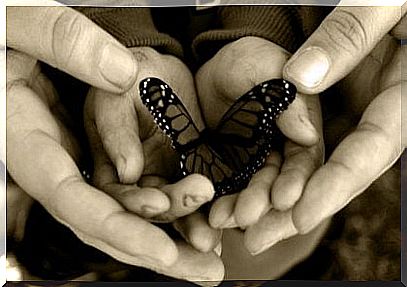Kindness Is A Language That Everyone Understands

Genuine kindness gives enormous strength to those who possess it. It goes far beyond good manners or formalities. When authentic, it reflects a true consideration and respect for others. It is also proof of a cultivated character and, above all, it is a key that opens most doors.
In truth, kindness is a language that everyone understands. And it is not a language to be used only in social gatherings, but mainly in difficult circumstances or with rough people. Almost all human beings are permeable / vulnerable to the force of an affable attitude.
Sometimes kindness is confused with hypocrisy. By showing false consideration for others or avoiding conflict by keeping quiet or using euphemisms for everything. This is not kindness, but calculation and manipulation. True kindness is mostly reflected in body language rather than protocols. And these are some keys to detect if it is genuine or not.
Eye contact and kindness
Eye contact is one of those aspects that reflects both hostility and kindness very well. Someone who refuses to look the other in the eye expresses a germ of rejection towards him. Who raises the chin, to look from above or over the shoulder, also reflects hostility.
In the language of kindness, the gaze is spontaneous and warm. A kind person looks into the eyes when the other is speaking and scatters the gaze when he is speaking. That is the natural way in which the eyes express themselves during normal conversation, in which people feel comfortable and fair.

The gestures of acceptance
When a person is really nice, he respects the opinions of others. He knows how to listen to them and find merit in what they say, even when it does not agree with them. That is why it is usual for you to show approval gestures in front of your interlocutor as a way to liven up the conversation.
Nodding the head or tilting it towards the other are expressions that encourage the interlocutor to keep talking. They facilitate their expression and break down any barriers that may exist. The smile is also a gesture of approval and acceptance. All this makes the atmosphere more relaxed and the connection with other people more real.
Balance in conversation
Although we are all trained to talk, few are those who take advantage of this “art”. When kindness is present, it is spontaneously understood that in that interaction there must be a balance. That there is a time to speak and another to listen. It is the only way to establish a two-way communication.
Monopolizing conversations or making them revolve around a topic that is not of common interest is a factor that strains communication. The ideal is always that everyone can participate. If there is no interest in imposing or showing off, this happens naturally, without making any effort to make it happen. what only interests one of those involved.

Flattery is not synonymous with kindness
There are people who constantly adopt the role of “hostess of life”, wherever or whenever they are. They make flattery a way of relating to others. They use seemingly loving words and attitudes toward others. However, they do it in series, automatically, as if reading a script that hardly conforms to what they really think.
Kindness has nothing to do with flattery. Honestly acknowledging the merits or achievements of the other is one thing and giving them your ears is another. Being nice is one thing and being a sweetheart, or sympathetic helper, is another. Kindness, even if it adapts to certain protocols, if you don’t need something, it’s theatrical.

Emphasize that kindness is one of the traits that are evaluated, for example, in one of the most popular personality tests. We are talking about the “Big Five” model of which we can find a good description in Jan JF Ter Laak’s study.
All human behavior, all words, are much better when carried out or said with kindness. If we were more consistent in this regard, surely we would be able to approach difficult moments or relationships with greater fluency and intelligence. Let us think that the lives of others and our own lives are always better when we add a touch of kindness to them.









